凯撒密码 C语言实现
python的凯撒密码算法

python的凯撒密码算法凯撒密码是一种简单的加密算法,它通过将明文中的每个字符替换为字母表中的固定位置的字符来达到加密的目的。
在本文中,我们将介绍如何使用Python实现凯撒密码算法。
一、算法概述凯撒密码的基本原理是将字母在字母表中按照固定的间隔位置进行移动,从而形成密文。
例如,如果我们将字母表中的字母“A”移动3个位置,那么移动后的密文将会是“D”。
这种加密方法相对简单,易于理解,但也容易受到攻击,因为它对大小写字母、数字和特殊符号的处理方式相同。
二、Python实现在Python中,我们可以使用字符串的切片和连接操作来实现凯撒密码算法。
以下是一个简单的实现示例:```pythondefcaesar_encrypt(text,shift):result=""foriinrange(len(text)):char=text[i]ifchar.isalpha():ascii_offset=ord('a')ifchar.islower()elseord('A')result+=chr((ord(char)-ascii_offset+shift)%26+ascii_offset)else:result+=charreturnresult```上述代码中,我们首先定义了一个名为`caesar_encrypt`的函数,它接受两个参数:要加密的文本和移动的偏移量。
在函数内部,我们使用一个循环遍历文本中的每个字符,如果是字母则按照凯撒密码的规则进行加密,否则直接添加到结果字符串中。
最后返回加密后的结果字符串。
三、示例应用下面是一个使用示例:```pythontext="Hello,world!"shift=3encrypted_text=caesar_encrypt(text,shift)print(encrypted_text)#Prints"Khoor,zruog!"```在上述示例中,我们将文本“Hello,world!”和移动偏移量3作为参数传递给`caesar_encrypt`函数,得到加密后的结果字符串“Khoor,zruog!”。
凯撒密码算法编程实现

凯撒密码算法编程实现凯撒密码是一种经典的加密算法,它通过将明文中的每个字符在字母表中向前或向后移动固定的位数来实现加密。
下面是使用 Python 语言实现凯撒密码算法的示例代码:```pythondef Caesar CipherEncryptDecrypt(message, shift):encryptedMessage = ""# 遍历 message 中的每个字符for char in message:# 判断字符是否为字母if char.isalpha():ascii_offset = ord('a') if char.islower() else ord('A')encryptedChar = chr((ord(char) - ascii_offset + shift) % 26 + ascii_offset)encryptedMessage += encryptedCharelse:encryptedMessage += charreturn encryptedMessage# 测试代码message = "Hello, World!"shift = 3print("原始消息:", message)encryptedMessage = CaesarCipherEncryptDecrypt(message, shift)print("加密后的消息:", encryptedMessage)decryptedMessage = CaesarCipherEncryptDecrypt(encryptedMessage, -shift)print("解密后的消息:", decryptedMessage)```在上述示例代码中,我们定义了一个名为 `CaesarCipherEncryptDecrypt` 的函数,它接受一个字符串 `message` 和一个整数 `shift` 作为参数,并返回加密或解密后的消息。
凯撒密码c语言编程实现

凯撒密码(Caesar Cipher)是一种最简单且最广为人知的加密技术之一。
它是一种替换密码,其中每个字母在原文中被偏移、移动固定的位置。
以下是一个使用C语言实现凯撒密码的示例:c#include <stdio.h>#include <string.h>void caesar_encrypt(char* plaintext, int shift) {char ciphertext[strlen(plaintext)];for (int i = 0; i < strlen(plaintext); i++) {char c = plaintext[i];if (c >= 'a' && c <= 'z') {ciphertext[i] = (c - 'a' + shift) % 26 + 'a';} else if (c >= 'A' && c <= 'Z') {ciphertext[i] = (c - 'A' + shift) % 26 + 'A';} else {ciphertext[i] = c;}}ciphertext[strlen(plaintext)] = '\0'; // Null-terminate the stringprintf("Ciphertext: %s\n", ciphertext);}int main() {char plaintext[100];int shift;printf("Enter the plaintext to be encrypted: ");fgets(plaintext, sizeof(plaintext), stdin); // Read plaintext from stdin plaintext[strcspn(plaintext, "\n")] = 0; // Remove newline character from inputprintf("Enter the shift value: ");scanf("%d", &shift); // Read shift value from stdincaesar_encrypt(plaintext, shift); // Encrypt the plaintext using the Caesar cipherreturn 0;}这个程序首先定义了一个名为caesar_encrypt的函数,它接受一个明文字符串和一个偏移量作为输入,然后生成并打印出相应的密文。
置换密码与凯撒密码加解密程序实现
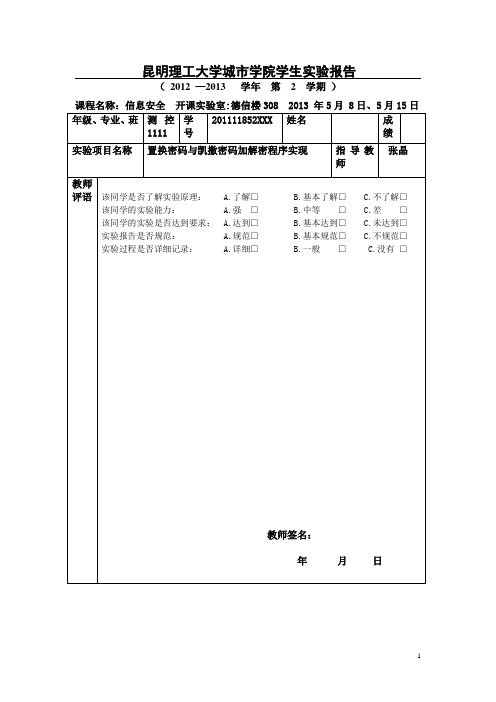
昆明理工大学城市学院学生实验报告(2012 —2013 学年第 2 学期)课程名称:信息安全开课实验室:德信楼308 2013 年5月 8日、5月15日一、实验目的及内容学会置换密码、凯撒密码加解密算法的编程实现二、实验原理及基本技术路线欲加密的数据称为明文,明文经过某种加密算法后转换成密文,加密算法中使用的参数称之为加密密钥;密文经解密算法作用后形成明文,解密算法也有一个密钥,这两个密钥可以相同也可以不相同。
密文在网络传输中可能会被窃听,特别是在无线通信中,所有传输信息是外露的,但是由于窃听者不知道解密的方法,安全可得到相对保护。
密码通信的一条基本原则是,必须假定破译知道通用的加密方法,也就是说加密算法E 是公开的。
这种假设是合理的也是必要的,因为事实上任何一种加密算法都不可能做到完全的保密,其次一个加密算法在被公开之后仍要能经得起攻击才能称得上是一个合格的、强壮加密算法。
另外只有在对加密算法进行不断的研究、攻击和改进中,密码学才能得到发展。
既然加密算法是可能公开的,那么真正的秘密就在于密钥了,也就是说,密钥是必须保密的,它通常是一个字符串,并且可以按需要进行频繁的更换,因此以下将讨论是模型是加密算法是公开的且相对稳定,而作为参数的密钥是保密的,并且是易于更换的。
在这里密钥的长度很重要,因为找到了解密密钥也就破译了密码,而密钥长度越长,密钥空间就越大,破译密钥所花的时间就越长,破译的可能性就越小。
从破译者的角度来看,密码分析所面对的问题有三种主要的变型:当仅有密文而无明文时,我们称之为“只有密文”问题;当已有了一批相匹配的明文与密文时,称之为“已知明文”问题;当能够加密自已所选的明文时,称为“选择明文”。
从这三种角度来看,如密码系统仅能经得起“只有密文”的攻击还不能算是真正的安全,因为破译者完全可能从统计学的角度与一般的通信规律中猜测出一部分的明文,从而就会拥有一些相匹配的明文与密文,从而全部解密。
凯撒密码,进制转化
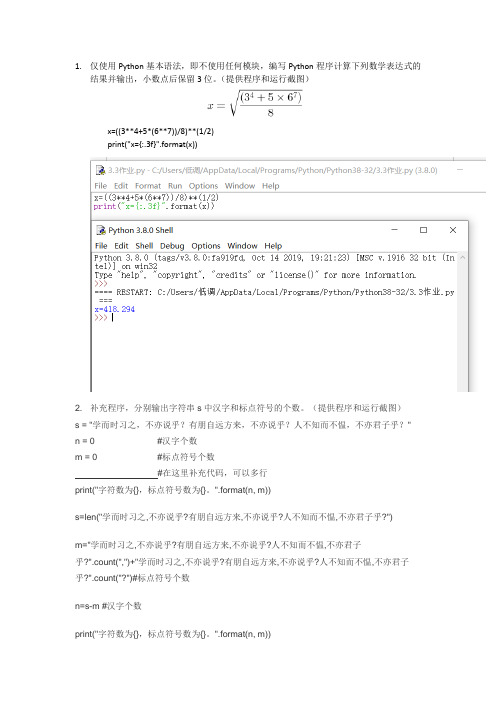
1.仅使用Python基本语法,即不使用任何模块,编写Python程序计算下列数学表达式的结果并输出,小数点后保留3位。
(提供程序和运行截图)x=((3**4+5*(6**7))/8)**(1/2)print("x={:.3f}".format(x))2. 补充程序,分别输出字符串s中汉字和标点符号的个数。
(提供程序和运行截图)s = "学而时习之,不亦说乎?有朋自远方来,不亦说乎?人不知而不愠,不亦君子乎?" n = 0 #汉字个数m = 0 #标点符号个数#在这里补充代码,可以多行print("字符数为{},标点符号数为{}。
".format(n, m))s=len("学而时习之,不亦说乎?有朋自远方来,不亦说乎?人不知而不愠,不亦君子乎?")m="学而时习之,不亦说乎?有朋自远方来,不亦说乎?人不知而不愠,不亦君子乎?".count(",")+"学而时习之,不亦说乎?有朋自远方来,不亦说乎?人不知而不愠,不亦君子乎?".count("?")#标点符号个数n=s-m #汉字个数print("字符数为{},标点符号数为{}。
".format(n, m))3.输入一个十进制数,分别输出其对应的二进制、八进制、小写十六进制和大写十六进制方式。
(提供程序和运行截图,比如用户输入123,程序运行输出1111011, 173, 7b, 7B)x=eval(input("请输入一个十进制数字:"))print("转换成二进制数为{:b},转换成八进制数为{:o},转换成小写十六进制为{:x},转换成大写十六进制为{:X}。
".format(x,x,x,x))4.凯撒密码解密算法的实现。
首先接收用户输入的加密文本,然后对字母a-z和字母A-Z按照密码算法进行反向转换,同时输出。
C语言加密与解密算法
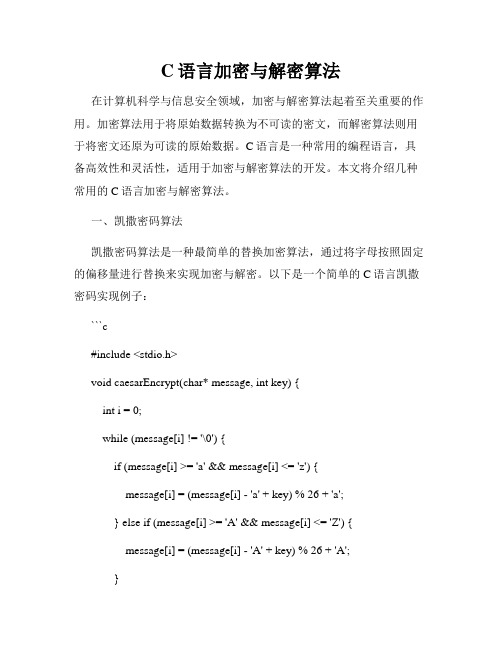
C语言加密与解密算法在计算机科学与信息安全领域,加密与解密算法起着至关重要的作用。
加密算法用于将原始数据转换为不可读的密文,而解密算法则用于将密文还原为可读的原始数据。
C语言是一种常用的编程语言,具备高效性和灵活性,适用于加密与解密算法的开发。
本文将介绍几种常用的C语言加密与解密算法。
一、凯撒密码算法凯撒密码算法是一种最简单的替换加密算法,通过将字母按照固定的偏移量进行替换来实现加密与解密。
以下是一个简单的C语言凯撒密码实现例子:```c#include <stdio.h>void caesarEncrypt(char* message, int key) {int i = 0;while (message[i] != '\0') {if (message[i] >= 'a' && message[i] <= 'z') {message[i] = (message[i] - 'a' + key) % 26 + 'a';} else if (message[i] >= 'A' && message[i] <= 'Z') {message[i] = (message[i] - 'A' + key) % 26 + 'A';}i++;}}void caesarDecrypt(char* message, int key) {int i = 0;while (message[i] != '\0') {if (message[i] >= 'a' && message[i] <= 'z') {message[i] = (message[i] - 'a' - key + 26) % 26 + 'a'; } else if (message[i] >= 'A' && message[i] <= 'Z') {message[i] = (message[i] - 'A' - key + 26) % 26 + 'A'; }i++;}}int main() {char message[] = "Hello, World!";int key = 3;printf("Original message: %s\n", message);caesarEncrypt(message, key);printf("Encrypted message: %s\n", message);caesarDecrypt(message, key);printf("Decrypted message: %s\n", message);return 0;}```以上程序演示了凯撒密码的加密与解密过程,通过指定偏移量实现对消息的加密与解密。
凯撒密码c语言
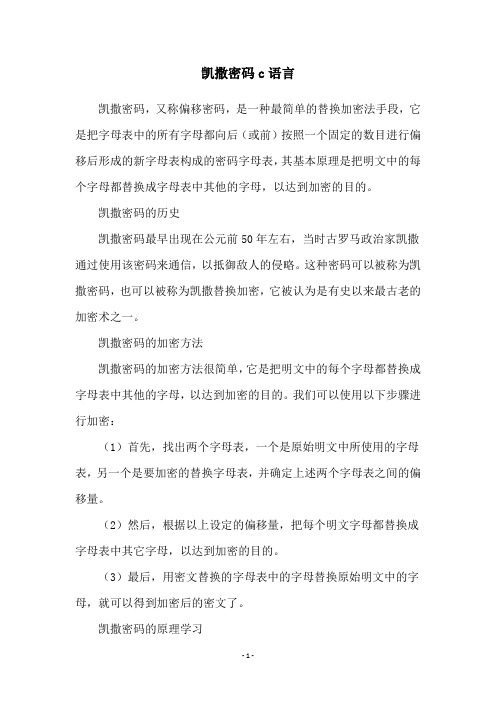
凯撒密码c语言凯撒密码,又称偏移密码,是一种最简单的替换加密法手段,它是把字母表中的所有字母都向后(或前)按照一个固定的数目进行偏移后形成的新字母表构成的密码字母表,其基本原理是把明文中的每个字母都替换成字母表中其他的字母,以达到加密的目的。
凯撒密码的历史凯撒密码最早出现在公元前50年左右,当时古罗马政治家凯撒通过使用该密码来通信,以抵御敌人的侵略。
这种密码可以被称为凯撒密码,也可以被称为凯撒替换加密,它被认为是有史以来最古老的加密术之一。
凯撒密码的加密方法凯撒密码的加密方法很简单,它是把明文中的每个字母都替换成字母表中其他的字母,以达到加密的目的。
我们可以使用以下步骤进行加密:(1)首先,找出两个字母表,一个是原始明文中所使用的字母表,另一个是要加密的替换字母表,并确定上述两个字母表之间的偏移量。
(2)然后,根据以上设定的偏移量,把每个明文字母都替换成字母表中其它字母,以达到加密的目的。
(3)最后,用密文替换的字母表中的字母替换原始明文中的字母,就可以得到加密后的密文了。
凯撒密码的原理学习用C语言实现凯撒密码,首先要熟悉凯撒密码的加密原理。
把原来的明文变成密文,可以利用以下步骤:(1)首先要确定一个偏移量n,可以编写一段程序,让用户输入一个 0-25数值,用来表示要偏移的距离:int n;printf(Please enter an integer 0-25: );scanf(%d &n);(2)然后,编写一段程序来读取原文:char c;char text[100];printf(Please enter the text: );scanf(%s text);(3)把字母表中的每一个字母都向后(或前)偏移n个字母,把偏移后的字母替换原文中的字母:for (int i = 0; i < strlen(text); i++){c = text[i];if (c >= a && c <= zc = (c - a + n) % 26 + aelse if (c >= A && c <= Zc = (c - A + n) % 26 + Atext[i] = c;}(4)最后,输出密文:printf(Encrypted Text: %stext);小结本文主要介绍了凯撒密码及其历史、加密方法及原理,以及如何使用C语言实现凯撒密码的加密程序。
凯撒密码 程序
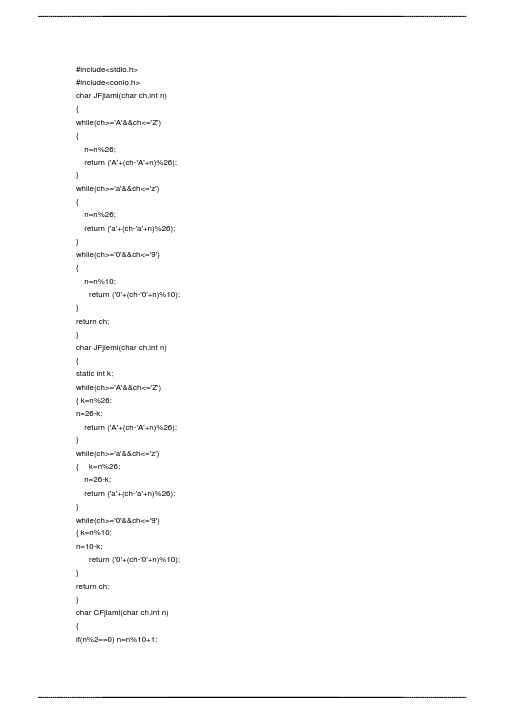
---------------------------------------------------------------------------------------------------------------------------------------------------------------------------------------------------------------------------------------------------------------------------------------------------------------------------------------------------------
---------------------------------------------------------------------------------------------------------------------------------------------------------------------------------------------------------------------------------------------------------------------------------------------------------------------------------------------------------
else n=n%10; if(n%5==0) n=n+2; else n=n; while(ch>='A'&&ch<='Z') {
信息安全古典密码之凯撒密码

《网络攻击与防御》实验报告计算机科学与技术学院计算机系网络教研室制一、实验目的(1)编程实现凯撒加密、解密算法,理解密码学基础知识,初步建立密码学思维方式。
(2)通过不断增加凯撒解密难度,理解唯密文解密,提高解密性能。
二、实验环境操作系统:Windows 10操作系统软件工具:C++语言编译环境三、实验内容与实验要求(1)在允许输入密码条件下,编程实现凯撒密码加解密解密。
要求:①从一文本文件读入英文文章(明文或密文)。
②对读入内容加密或解密后写入另一文本文件。
(2)在不允许输入密码条件下,编程实现解密凯撒密码加密密文。
要求绘制三种情况下解密程序流程图,说明不同解密程序存在的不足。
程序需要计算、显示解密使用时间(单位:ms)。
①已知c1 =wklv lv d errn,求p1。
(初级解密)问:两次使用凯撒,能否正确解密?(字符串用凯撒加密后的结果再用凯撒加密一次。
)②已知c1 =go kbo cdenoxdc,或c1 =zh duh vwxghqwv,求p1。
(中级解密)③已知c1 =rxwvlgh wkh eleoh, wkhvh vla zrugv duh wkh prvw idprxv lq doo wkh olwhudwxuh ri wkh zruog. wkhb zhuh vsrnhq eb kdpohw zkhq kh zdv wklqnlqj dorxg, dqg wkhb duh wkh prvw idprxv zrugv lq vkdnhvshduh ehfdxvh kdpohw zdv vshdnlqj qrw rqob iru klpvhoi exw dovr iru hyhub wklqnlqj pdq dqg zrpdq. wr eh ru qrw wr eh, wr olyh ru qrw wr olyh, wr olyh ulfkob dqg dexqgdqwob dqg hdjhuob, ru wr olyh gxoob dqg phdqob dqg vfdufhob. d sklorvrskhu rqfh zdqwhg wr nqrz zkhwkhu kh zdv dolyh ru qrw, zklfk lv d jrrg txhvwlrq iru hyhubrqh wr sxw wr klpvhoi rffdvlrqdoob. kh dqvzhuhg lw eb vdblqj: "l wklqn, wkhuhiruh dp." ,求p1。
c++凯撒密码编程
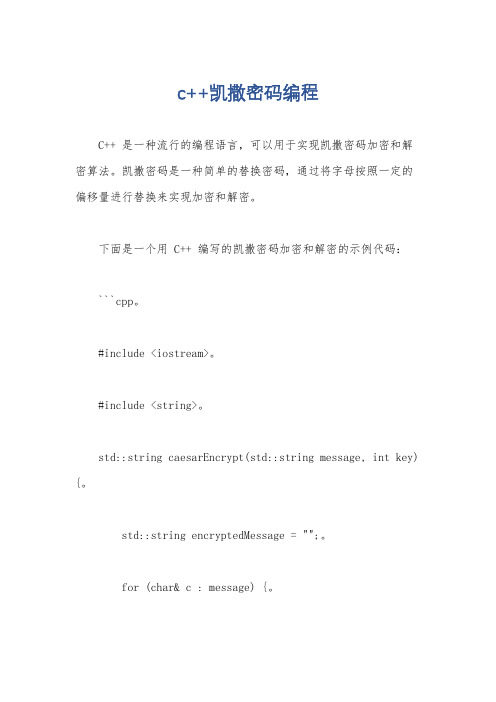
c++凯撒密码编程C++ 是一种流行的编程语言,可以用于实现凯撒密码加密和解密算法。
凯撒密码是一种简单的替换密码,通过将字母按照一定的偏移量进行替换来实现加密和解密。
下面是一个用 C++ 编写的凯撒密码加密和解密的示例代码:```cpp。
#include <iostream>。
#include <string>。
std::string caesarEncrypt(std::string message, int key) {。
std::string encryptedMessage = "";。
for (char& c : message) {。
if (isalpha(c)) {。
char base = isupper(c) ? 'A' : 'a';。
c = (c - base + key) % 26 + base;。
}。
encryptedMessage += c;。
}。
return encryptedMessage;。
}。
std::string caesarDecrypt(std::string message, int key) {。
return caesarEncrypt(message, 26 - key);。
}。
int main() {。
std::string message = "Hello, World!";。
int key = 3;。
std::string encryptedMessage = caesarEncrypt(message, key);。
std::cout << "Encrypted message: " << encryptedMessage << std::endl;。
std::string decryptedMessage = caesarDecrypt(encryptedMessage, key);。
c语言解密代码
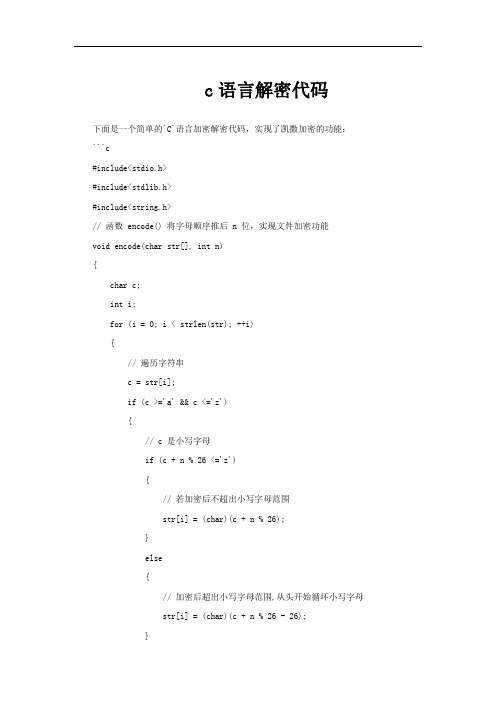
c语言解密代码下面是一个简单的`C`语言加密解密代码,实现了凯撒加密的功能:```c#include<stdio.h>#include<stdlib.h>#include<string.h>// 函数 encode() 将字母顺序推后 n 位,实现文件加密功能void encode(char str[], int n){char c;int i;for (i = 0; i < strlen(str); ++i){// 遍历字符串c = str[i];if (c >='a' && c <='z'){// c 是小写字母if (c + n % 26 <='z'){// 若加密后不超出小写字母范围str[i] = (char)(c + n % 26);}else{// 加密后超出小写字母范围,从头开始循环小写字母 str[i] = (char)(c + n % 26 - 26);}elseif (c >='A' && c <='Z'){// c 为大写字母if (c + n % 26 <= 'Z'){// 加密后不超出大写字母范围str[i] = (char)(c + n % 26);}else{// 加密后超出大写字母范围,从头开始循环大写字母 str[i] = (char)(c + n % 26 - 26);}}else{// 不是字母,不加密str[i] = c;printf("\nAfter encode: \n");puts(str);}}// 输出加密后的字符串printf("\nAfter encode: \n");puts(str);}// 实现解密功能,将字母顺序前移 n 位void decode(char str[], int n){int i;for (i = 0; i < strlen(str); ++i){c = str[i];if (c >='a' && c <='z'){// 解密后还为小写字母,直接解密if (c - n % 26 >='a'){str[i] = (char)(c - n % 26);}else{// 解密后不为小写字母了,通过循环小写字母处理为小写字母 str[i] = (char)(c - n % 26 + 26);}}elseif (c >= 'A' && c <='Z'){// c 为大写字母if (c - n % 26 >='A'){// 解密后还为大写字母str[i] = (char)(c - n % 26);}else{// 解密后不为大写字母了,循环大写字母,处理为大写字母str[i] = (char)(c - n % 26 + 26);}}else{// 不是字母,不加密str[i] = c;}}// 输出解密后的字符串printf("\nAfter decode: \n");puts(str);}int main(){char str[20];int n;printf("请输入字符串(以空格结束输入):\n");gets(str);printf("请输入密钥(1-25的整数):\n");scanf("%d", &n);printf("加密前的字符串为:%s\n", str);encode(str, n);printf("加密后的字符串为:%s\n", str);decode(str, n);printf("解密后的字符串为:%s\n", str);return 0;}```在上述代码中,加密函数`encode()`通过将字符串中的每个字符循环向后移动`n`位实现加密,解密函数`decode()`通过将字符串中的每个字符循环向前移动`n`位实现解密。
凯撒密码的算法c语言

凯撒密码的算法c语言凯撒密码是一种非常古老的加密方法,相传当年凯撒大地行军打仗时为了保证自己的命令不被敌军知道,就使用这种特殊的方法进行通信,以确保信息传递的安全。
他的原理很简单,说到底就是字母于字母之间的替换。
下面让我们看一个简单的例子:“baidu”用凯撒密码法加密后字符串变为“edlgx”,它的原理是什么呢,把“baidu”中的每一个字母按字母表顺序向后移3位,所得的结果就是刚才我们所看到的密文。
#include <stdio.h>main(){char M[100];char C[100];int K=3,i;printf("请输入明文M(注意不要输入空白串)\n");gets(M);for(i=0;M[i]!='\0';i++)C[i]=(M[i]-'a'+K)%26+'a';C[i]='\0';printf("结果是:\n%s\n",C);}1、程序结构化,用函数分别实现2、对文件的加密,解密输出到文件#include<stdio.h>#include<conio.h>void menu()/*菜单,1.加密 2.解密 3.退出*/{clrscr();printf("\n========================================================== =====================");printf("\n1.Encrypt the file"); printf("\n2.Decrypt the file"); printf("\n3.Quit\n");printf("============================================================ ===================\n");printf("Please select a item:"); return;}char encrypt(char ch,int n)/*加密函数,把字符向右循环移位n*/ { while(ch>='A'&&ch<='Z'){return ('A'+(ch-'A'+n)%26); }while(ch>='a'&&ch<='z'){return ('a'+(ch-'a'+n)%26); }return ch;}main(){int i,n;char ch0,ch1;FILE *in,*out;char infile[10],outfile[10]; textbackground(RED);textcolor(LIGHTGREEN);clrscr();menu();ch0=getch();while(ch0!='3'){if(ch0=='1'){clrscr();printf("\nPlease input the infile:");scanf("%s",infile);/*输入需要加密的文件名*/ if((in=fopen(infile,"r"))==NULL){printf("Can not open the infile!\n");printf("Press any key to exit!\n");getch();exit(0);}printf("Please input the key:");scanf("%d",&n);/*输入加密密码*/printf("Please input the outfile:");scanf("%s",outfile);/*输入加密后文件的文件名*/ if((out=fopen(outfile,"w"))==NULL){printf("Can not open the outfile!\n");printf("Press any key to exit!\n");fclose(in);getch();exit(0);}while(!feof(in))/*加密*/{fputc(encrypt(fgetc(in),n),out);}printf("\nEncrypt is over!\n");fclose(in);fclose(out);sleep(1);}if(ch0=='2'){clrscr();printf("\nPlease input the infile:");scanf("%s",infile);/*输入需要解密的文件名*/if((in=fopen(infile,"r"))==NULL){printf("Can not open the infile!\n");printf("Press any key to exit!\n");getch();exit(0);}printf("Please input the key:");scanf("%d",&n);/*输入解密密码(可以为加密时候的密码)*/ n=26-n;printf("Please input the outfile:");scanf("%s",outfile);/*输入解密后文件的文件名*/if((out=fopen(outfile,"w"))==NULL){printf("Can not open the outfile!\n");printf("Press any key to exit!\n");fclose(in);getch();exit(0);}while(!feof(in)){fputc(encrypt(fgetc(in),n),out); }printf("\nDecrypt is over!\n"); fclose(in);fclose(out);sleep(1);}clrscr();printf("\nGood Bye!\n"); sleep(3); getch();}}。
c语言实现凯撒密码算法

凯撒密码是一种简单的加密算法,它通过将明文中的每个字符向后(或向前)移动固定的位数来加密文本。
以下是一个使用C语言实现凯撒密码算法的示例代码:c复制代码#include<stdio.h>#include<string.h>void caesar_encrypt(char *plaintext, int shift) {int len = strlen(plaintext);for (int i = 0; i < len; i++) {if (plaintext[i] >= 'a' && plaintext[i] <= 'z') {plaintext[i] = 'a' + ((plaintext[i] - 'a' + shift) % 26);} else if (plaintext[i] >= 'A' && plaintext[i] <= 'Z') {plaintext[i] = 'A' + ((plaintext[i] - 'A' + shift) % 26);}}}void caesar_decrypt(char *ciphertext, int shift) {int len = strlen(ciphertext);for (int i = 0; i < len; i++) {if (ciphertext[i] >= 'a' && ciphertext[i] <= 'z') {ciphertext[i] = 'a' + ((ciphertext[i] - 'a' - shift + 26) % 26);} else if (ciphertext[i] >= 'A' && ciphertext[i] <= 'Z') {ciphertext[i] = 'A' + ((ciphertext[i] - 'A' - shift + 26) % 26);}}}int main() {char plaintext[] = "hello world";char ciphertext[strlen(plaintext)];char decryptedtext[strlen(plaintext)];int shift = 3; // 加密偏移量,可以根据需要调整// 加密caesar_encrypt(ciphertext, shift);printf("Ciphertext: %s\n", ciphertext); // 输出加密后的文本// 解密caesar_decrypt(decryptedtext, -shift);printf("Decrypted text: %s\n", decryptedtext); // 输出解密后的文本return0;}该程序首先定义了两个函数caesar_encrypt和caesar_decrypt,分别用于加密和解密文本。
凯撒密码加密C语言简单实现
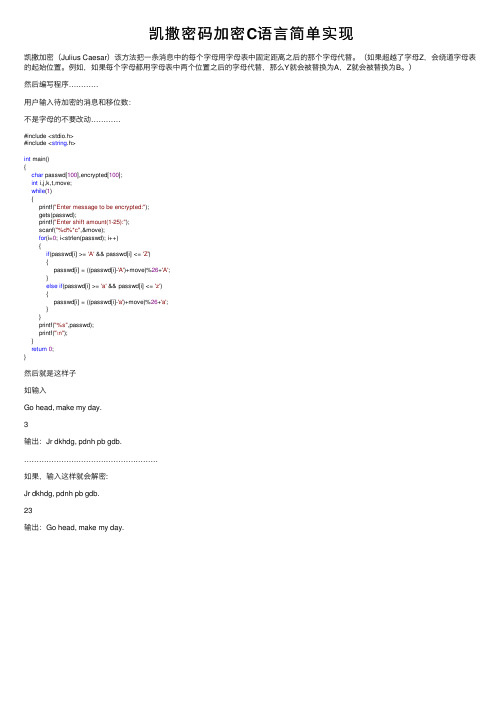
凯撒密码加密C语⾔简单实现凯撒加密(Julius Caesar)该⽅法把⼀条消息中的每个字母⽤字母表中固定距离之后的那个字母代替。
(如果超越了字母Z,会绕道字母表的起始位置。
例如,如果每个字母都⽤字母表中两个位置之后的字母代替,那么Y就会被替换为A,Z就会被替换为B。
)然后编写程序…………⽤户输⼊待加密的消息和移位数:不是字母的不要改动…………#include <stdio.h>#include <string.h>int main(){char passwd[100],encrypted[100];int i,j,k,t,move;while(1){printf("Enter message to be encrypted:");gets(passwd);printf("Enter shift amount(1-25):");scanf("%d%*c",&move);for(i=0; i<strlen(passwd); i++){if(passwd[i] >= 'A' && passwd[i] <= 'Z'){passwd[i] = ((passwd[i]-'A')+move)%26+'A';}else if(passwd[i] >= 'a' && passwd[i] <= 'z'){passwd[i] = ((passwd[i]-'a')+move)%26+'a';}}printf("%s",passwd);printf("\n");}return0;}然后就是这样⼦如输⼊Go head, make my day.3输出:Jr dkhdg, pdnh pb gdb.………………………………………………如果,输⼊这样就会解密:Jr dkhdg, pdnh pb gdb.23输出:Go head, make my day.。
凯撒密码编程实验报告(3篇)

第1篇一、实验目的1. 理解凯撒密码的基本原理和加密解密过程;2. 掌握C语言编程实现凯撒密码;3. 提高编程能力和密码学基础知识。
二、实验环境1. 软件工具:Visual Studio 20192. 操作系统:Windows 10三、实验内容1. 凯撒密码原理介绍凯撒密码是一种最简单的移位密码,通过将字母表中的每个字母向前或向后移动固定数量位置来进行加密和解密。
例如,密钥为3时,A会被加密为D,B会被加密为E,以此类推。
解密过程是将密文中的每个字母向前或向后移动相同的位数,恢复出明文。
2. C语言实现凯撒密码(1)加密函数```cvoid caesar_encrypt(char input, char output, int key) {int i = 0;while (input[i] != '\0') {if (input[i] >= 'A' && input[i] <= 'Z') {output[i] = ((input[i] - 'A' + key) % 26) + 'A';} else if (input[i] >= 'a' && input[i] <= 'z') {output[i] = ((input[i] - 'a' + key) % 26) + 'a';} else {output[i] = input[i];}i++;}output[i] = '\0';}```(2)解密函数```cvoid caesar_decrypt(char input, char output, int key) {int i = 0;while (input[i] != '\0') {if (input[i] >= 'A' && input[i] <= 'Z') {output[i] = ((input[i] - 'A' - key + 26) % 26) + 'A'; } else if (input[i] >= 'a' && input[i] <= 'z') {output[i] = ((input[i] - 'a' - key + 26) % 26) + 'a'; } else {output[i] = input[i];}i++;}output[i] = '\0';}```3. 测试程序```cinclude <stdio.h>include <string.h>void caesar_encrypt(char input, char output, int key) { // 加密函数}void caesar_decrypt(char input, char output, int key) { // 解密函数}int main() {char input[100], output[100];int key;printf("请输入密钥(1-25): ");scanf("%d", &key);printf("请输入明文: ");scanf("%s", input);caesar_encrypt(input, output, key);printf("加密结果: %s\n", output);caesar_decrypt(output, input, key);printf("解密结果: %s\n", input);return 0;}```四、实验结果与分析1. 实验结果(1)输入密钥为3,明文为"hello world",加密结果为"kiho world",解密结果为"hello world";(2)输入密钥为5,明文为"goodbye world",加密结果为"jvvhv world",解密结果为"goodbye world"。
凯撒密码的加密和解密
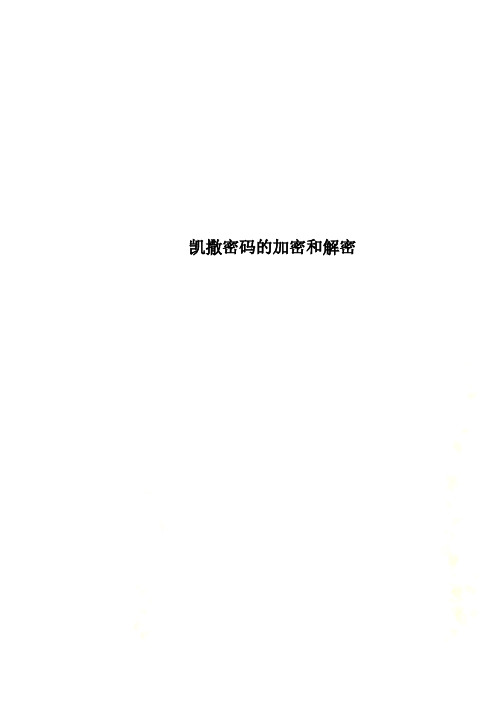
凯撒密码的加密和解密关于凯撒密码的实现原理班级:姓名:学号:指导老师:一、设计要求说明1、设计一个凯撒密码的加密和解密的程序,要求输入一段字符和密码,输出相应的密文,完成加密过程;若输入被加密的密文及解密密钥,能还原出原文,完成解密。
2、语言不限,工具不限,独立完成,参加答辩。
3、严格按照格式的要求完成文档,在第六部分的运行结果分析中,要求抓图说明。
二、基础知识介绍凯撒密码的历史凯撒密码(caeser)是罗马扩张时期朱利斯•凯撒(Julius Caesar)创造的,用于加密通过信使传递的作战命令。
它将字母表中的字母移动一定位置而实现加密。
古罗马随笔作家修托尼厄斯在他的作品中披露,凯撒常用一种“密表”给他的朋友写信。
这里所说的密表,在密码学上称为“凯撒密表”。
用现代的眼光看,凯撒密表是一种相当简单的加密变换,就是把明文中的每一个字母用它在字母表上位置后面的第三个字母代替。
古罗马文字就是现在所称的拉丁文,其字母就是我们从英语中熟知的那26个拉丁字母。
因此,凯撒密表就是用d代a,用e代b,……,用z代w。
这些代替规则也可用一张表格来表示,所以叫“密表”。
基本原理在密码学中存在着各种各样的置换方式,但所有不同的置换方式都包含2个相同的元素。
密钥和协议(算法)。
凯撒密码的密钥是3,算法是将普通字母表中的字母用密钥对应的字母替换。
置换加密的优点就在于它易于实施却难于破解. 发送方和接收方很容易事先商量好一个密钥,然后通过密钥从明文中生成密文,即是敌人若获取密文,通过密文直接猜测其代表的意义,在实践中是不可能的。
凯撒密码的加密算法极其简单。
其加密过程如下:在这里,我们做此约定:明文记为m,密文记为c,加密变换记为E(k1,m)(其中k1为密钥),解密变换记为D(k2,m)(k2为解密密钥)(在这里k1=k2,不妨记为k)。
凯撒密码的加密过程可记为如下一个变换:c≡m+k mod n (其中n为基本字符个数)同样,解密过程可表示为:m≡c+k mod n (其中n为基本字符个数)对于计算机而言,n可取256或128,m、k、c均为一个8bit的二进制数。
凯撒算法的加密和解密过程C

凯撒算法的加密和解密过程C凯撒密码(Caesar cipher)是一种简单的替换密码,它通过将明文中的每个字母替换为字母表中的相邻字母来实现加密和解密过程。
加密过程中,明文中的每个字母都会向右移动固定的位数(偏移量),而解密过程中则是向左移动相同的位数。
下面是凯撒算法的加密过程的C语言实现代码示例:```c#include <stdio.h>#include <string.h>#include <ctype.h>//凯撒加密函数void caesarEncrypt(char* message, int offset)int len = strlen(message);for (int i = 0; i < len; i++)if (isalpha(message[i]))if (isupper(message[i]))message[i] = (message[i] - 'A' + offset) % 26 + 'A';} else if (islower(message[i]))message[i] = (message[i] - 'a' + offset) % 26 + 'a';}}}int maichar message[100];int offset;printf("请输入要加密的消息:");fgets(message, sizeof(message), stdin);printf("请输入偏移量:");scanf("%d", &offset);caesarEncrypt(message, offset);printf("加密后的消息:%s", message);return 0;```以上代码首先定义了一个`caesarEncrypt`函数,用于实现凯撒加密过程。
恺撒密码的C实现 实验报告

凯撒加密的C实现实验报告1.凯撒密码简介它是一种代换密码。
据说恺撒是率先使用加密函的古代将领之一,因此这种加密方法被称为恺撒密码。
凯撒密码作为一种最为古老的对称加密体制,在古罗马的时候都已经很流行,他的基本思想是:通过把字母移动一定的位数来实现加密和解密。
明文中的所有字母都在字母表上向后(或向前)按照一个固定数目进行偏移后被替换成密文。
例如,当偏移量是3的时候,所有的字母A将被替换成D,B 变成E,以此类推X将变成A,Y变成B,Z变成C。
由此可见,位数就是凯撒密码加密和解密的密钥2.程序的运行1.程序运行2.加密(密钥为2)3.解密程序代码:(具体见附件源程序)1.加密代码void C凯撒Dlg::OnBnClickedOk(){// TODO: 在此添加控件通知处理程序代码UpdateData(1);int i, num;char ch1[100] = {0},ch2[100] = {0};strcpy(ch2,m_mingwen);num = strlen(ch2);for(i=0;i<num;i++){if(ch2[i] >= 'a'&&ch2[i] <= 'z'){if(ch2[i]+m_miyue <= 'z'&&ch2[i] >= 'a'){ch1[i] = ch2[i] + m_miyue;}elsech1[i] = ch2[i] + m_miyue - 25;}if(ch2[i] >= 'A'&&ch2[i] <= 'Z'){if(ch2[i]+m_miyue <= 'Z'&&ch2[i] >= 'A'){ch1[i] = ch2[i] + m_miyue;}elsech1[i] = ch2[i] + m_miyue - 25;}}printf("%s\n",ch1);m_miwen = ch1;UpdateData(0);}2.解密代码void C凯撒Dlg::OnBnClickedButton1(){// TODO: 在此添加控件通知处理程序代码UpdateData(1);int i, num;char ch1[100] = {0},ch2[100] = {0};strcpy(ch2,m_miwen);num = strlen(ch2);for(i=0;i<num;i++){if(ch2[i] >= 'a'&&ch2[i] <= 'z'){if(ch2[i]-m_miyue >= 'a'){ch1[i] = ch2[i] - m_miyue;}elsech1[i] = ch2[i] - m_miyue + 25;}if(ch2[i] >= 'A'&&ch2[i] <= 'Z'){if(ch2[i]-m_miyue >= 'A'){ch1[i] = ch2[i] - m_miyue;}elsech1[i] = ch2[i] - m_miyue + 25;}}printf("%s\n",ch1);m_jiemi = ch1;UpdateData(0);}。
密码学实验之凯撒密码和维吉尼亚密码的加解密

1.凯撒密码的加解密源代码:#include<stdafx.h>#include <stdio.h>#include <string.h>int main(){char s[100],c;int i,p,d,e;printf("请选择: A.加密B.解密Q.退出\n"); scanf("%c",&c);if(c=='a'||c=='A'){printf("输入明文:");scanf("%s",&s);p=strlen(s);printf("请设置偏移量:");scanf("%d",&d);for(i=0;i<p;i++){if(s[i]>='a' && s[i]<='z')s[i]=(s[i]-'a'+d)%26+'a';else if(s[i]>='A' && s[i]<='Z')s[i]=(s[i]-'A'+d)%26+'A';else s[i]=s[i]+d;}printf("%s",s);printf("\n\n\n");}if(c=='b'||c=='B'){printf("请输入密文:");scanf("%s",&s);p=strlen(s);printf("请输入加密的偏移变量:");scanf("%d",&d);for(i=0;i<p;i++){if(s[i]>='a' && s[i]<='z'){e=s[i]-'a'-d;if(e<=0)s[i]=(e+26)%26+'a';else s[i]=e%26+'a';}else if(s[i]>='A' && s[i]<='Z'){e=s[i]-'A'-d;if(e<0)s[i]=(e+26)%26+'A';else s[i]=e%26+'A';}else s[i]=s[i]-d;}printf("%s",s);printf("\n\n");}if(c=='q'||c=='Q')return 0;return 0;}运行结果是:2.维吉尼亚密码的加解密源代码:#include "stdafx.h"#include<iostream>using namespace std;#define MINCHAR 32#define CHARSUM 94char table[CHARSUM][CHARSUM];bool Init();bool Encode(char* key, char* source, char* dest);bool Dncode(char* key, char* source, char* dest);int main(){if(!Init()){cout << "初始化错误!" << endl;return 1;}char key[256];char str1[256];char str2[256];int operation;while(1){do{cout << "请选择一个操作:1. 加密;2. 解密;-1. 退出\n"; cin >> operation;}while(operation != -1 && operation != 1 && operation != 2);if(operation == -1)return 0;else if(operation == 1)//加密{cout << "请输入密钥:";cin >> key;cout << "请输入待加密字符串:";cin >> str1;Encode(key, str1, str2);cout << "加密后的字符串:" << str2 << endl;}else if(operation == 2)//解密{cout << "请输入密钥:";cin >> key;cout << "请输入待解密字符串:";cin >> str1;Dncode(key, str1, str2);cout << "解密后的字符串:" << str2 << endl;}cout << endl;}return 0;}// 初始化维吉尼亚方阵bool Init(){int i, j;for(i = 0; i < CHARSUM; i++){for(j = 0; j < CHARSUM; j++){table[i][j] = MINCHAR + (i + j) % CHARSUM;}}return true;}// 加密// key:密钥// source:待加密的字符串// dest:经过加密后的字符串bool Encode(char* key, char* source, char* dest){char* tempSource = source;char* tempKey = key;char* tempDest = dest;do{*tempDest = table[(*tempKey) - MINCHAR][(*tempSource) - MINCHAR]; tempDest++;if(!(*(++tempKey)))tempKey = key;}while(*tempSource++);dest[strlen(source)] = 0;return true;}// 解密// key:密钥// source:待解密的字符串// dest:经过解密后的字符串bool Dncode(char* key, char* source, char* dest){char* tempSource = source;char* tempKey = key;char* tempDest = dest;char offset;do{offset = (*tempSource) - (*tempKey);offset = offset >= 0 ? offset : offset + CHARSUM; *tempDest = MINCHAR + offset;tempDest++;if(!(*(++tempKey)))tempKey = key;}while(*++tempSource);dest[strlen(source)] = 0;return true;}运行结果如下:。
古典密码-凯撒密码原理以及代码

古典密码-凯撒密码原理以及代码⽬录古典密码--->凯撒密码⼀⼂凯撒密码1.1 什么是凯撒密码凯撒密码,想必很多⼈听说过.没听说过的简单说⼀下.相传在很久很久以前,有⼀位皇帝,叫做尤利乌斯 · 凯撒为了缩短名字,我们称为凯撒⼤帝.是在公元前100年左右单⾝与古罗马,是⼀名著名的军事统帅.由它发明的密码.叫做凯撒密码1.2 凯撒密码的加密原理凯撒密码其实很简单. 需要我们理解平移概念 ,就是将⼀段数据平移多少位, 最后解密的时候进⾏反平移即可得出.以字母 a-z来说我们将a 进⾏平移3位得出密⽂如下图:将a 平移三位,得出 D b则是E 以此类推. 如果到达末尾,则从头开始. 例如Z 是字母的末尾.平移三位则是 C那么由此得出公式密⽂ = 函数(明⽂ + 平移位数(key) Mod 26;明⽂ = 函数(密⽂ - 平移位数(key) mod 26;其中密⽂明⽂函数平移位数等都是有英⽂含义的.所以我们很多时候都能看到如下写法c = E(p + k) mod 26p = D(c - k) mod 26C = Ciphertext 英⽂意思是密码密⽂的意思p = plainttext 英⽂意思是明⽂的意思,也就是未加密之前的数据E = encrypt 英⽂的意思是加密的意思. 放在我们编程中则可以理解为是⼀个⽅法.专门⽤于加密的⽅法D = Decrypt 英⽂意思是解密的意思同加密⼀样k = key 英⽂意思是钥匙的意思. 也就是解密的钥匙或者加密的钥匙mod 数学上取余数的意思 10 % 2 == 0 取得余数为0综上所述,⼤概是了解以下基本的术语密⽂ = 加密函数(明⽂ + key) % 26明⽂ = 解密函数(密⽂ - key) % 261.3 凯撒密码的破解其实凯撒密码是⾮常好破解的. 假设你不知道明⽂.只知道密⽂.那么总是可以尝试出来的. 总共是26次.依次破解. 我们常听的暴⼒破解就是这个意思. 也称为穷举那怎么知道凯撒密码破解出来是否正确. 是这样的. 明⽂⼀般都是有意义的.当你⽤密⽂破解的时候会出现很多⽆意义的数据.⽽有些数据是很有意义的.所以我可推断以下.假设不是.那么总过26组破解密码.⼀个⼀个尝试也能知道的.⼆⼂凯撒密码代码编写2.1 C/C++代码,编写加解密函数既然我们知道了公式c = e(p + k) % 26那么我们根据公式来即可代码void Entrypt(IN char* PlaintText, IN int PlaintTextSize, OUT char* CipText){//加密PlaintTextfor (auto i = 0; i < PlaintTextSize; i++){/*1.⾸先字符 - 字符'a'得出下标.2.下标 + 则是代表假⾯3.如果是加密,怎么下标不能超过26. 所以 % 264.计算完的结果加上'a' 就等于实际加密的密⽂了*/char ch = (PlaintText[i] - 'a' + 3); //得出下标char ch1 = ch % 26 + 'a'; //得出实际密⽂//接受的密⽂数组CipText[i] = ch1;}return;}//解密数据,与加密相反void Detrypt(IN char* CipText, IN int CipTextSize, OUT char* PlaintText){//加密PlaintTextfor (auto i = 0; i < CipTextSize; i++){/*1.⾸先字符 - 字符'a'得出下标.2.下标 - 则是代表解密3.如果是- 则会出现复数情况, 如 a的下标为0 a - 3 = 负数. 那么需要加26进⾏调整. 调整之后是绝对不会超过26的4.虽然不会超过.但是也要 % 26.因为如果是正数的情况,如果你加26那么还是会超过26*/char ch = (CipText[i] - 'a' - 3); //得出下标char ch1 = (ch + 26); //负数调整,char ch3 = ch1 % 26 + 'a'; //正数 % 26得出下标,下标 + 'a'//接受的密⽂数组PlaintText[i] = ch3;}return;}int main(){//c = entrypt(p + k) % 26//char szBuffer[] = "ibinary";char PlaintText[] = "ibinary";char CipText[8] = { 0 };char PlanitText1[8] = { 0 };Entrypt(PlaintText, strlen(PlaintText), CipText);printf("加密明⽂后的密⽂ = %s \r\n", CipText);Detrypt(CipText, strlen(CipText), PlanitText1);printf("解密密⽂后的明⽂ = %s \r\n", PlanitText1);system("pause");return 0;}。
- 1、下载文档前请自行甄别文档内容的完整性,平台不提供额外的编辑、内容补充、找答案等附加服务。
- 2、"仅部分预览"的文档,不可在线预览部分如存在完整性等问题,可反馈申请退款(可完整预览的文档不适用该条件!)。
- 3、如文档侵犯您的权益,请联系客服反馈,我们会尽快为您处理(人工客服工作时间:9:00-18:30)。
main() { int i,n;源自char ch0,ch1; FILE *in,*out; char infile[10],outfile[10];
textbackground(RED); textcolor(LIGHTGREEN); clrscr();
menu(); ch0=getch();
while(ch0!='3') { if(ch0=='1') {
for(ch='a',j=0;ch<='z';ch++,j++) {
if(*(Plaintext+i)==ch) {
*(Plaintext+i)=*(keyword+j); break; } } } return Plaintext; }
char *Decrypt(char *keyword,char *Plaintext) /*解密*/ {
clrscr(); printf("\nPlease input the infile:"); scanf("%s",infile);/*输入需要加密的文件名*/
if((in=fopen(infile,"r"))==NULL) {
printf("Can not open the infile!\n"); printf("Press any key to exit!\n"); getch(); exit(0); }
void main() {
char *keyword,*Plaintext,*tmp=NULL; keyword=(char*)malloc(sizeof(char)); Plaintext=(char*)malloc(sizeof(char));
printf("Input key word:"); /*输入欲用密钥*/ gets(keyword); printf("Input Plaintext:"); /*输入要转换的明文*/ gets(Plaintext);
char ch; int i,j; for(i=0;*(Plaintext+i)!='\0';i++) {
for(ch='a',j=0;*(keyword+j)!='\0';ch++,j++) {
if(*(Plaintext+i)==*(keyword+j)) {
*(Plaintext+i)=ch; break; } } } return Plaintext; }
if(*(keyword+i)=='\0') {
*(keyword+t)=ch; t++; break; } } } *(keyword+t)='\0'; }
char *Ciphertext(char *keyword,char *Plaintext) /*按密码表加密*/ {
char ch; int i,j; for(i=0;*(Plaintext+i)!='\0';i++) {
/**凯撒密码实现 要求,将明文字母变成它后面第三个字母,后面的循环到前面! 公式为 f(a)=(f(a)+3)%26
*/ #include <stdio.h> int main() {
char P[100];/*定义明文长度*/ char C[100];/*定义密文长度*/ int K=3,i; printf("Please input Plaintext:\n"); /*输入明文*/ gets(P); /* 接受明文*/
if(*(pwd+i)>='a'&&*(pwd+i)<='z') {
if(*(pwd+i)-'a'>=key%26) *(pwd+i)=*(pwd+i)-key%26;
else *(pwd+i)='z'-(key%26-(*(pwd+i)-'a'))-1; } else if(*(pwd+i)>='A'&&*(pwd+i)<='Z') {
n=26-n;
printf("Please input the outfile:"); scanf("%s",outfile);/*输入解密后文件的文件名*/
if((out=fopen(outfile,"w"))==NULL) {
printf("Can not open the outfile!\n"); printf("Press any key to exit!\n"); fclose(in); getch(); exit(0); }
char encrypt(char ch,int n)/*加密函数,把字符向右循环移位 n*/ { while(ch>='A'&&ch<='Z') { return ('A'+(ch-'A'+n)%26); } while(ch>='a'&&ch<='z') { return ('a'+(ch-'a'+n)%26); } return ch; }
for(i=0;P[i]!='\0';i++) { /*逐个判断字母的大小*/ if(P[i]>='a'&&P[i]<='z') /*小写字母 */ C[i]=(P[i]-'a'+K)%26+'a'; else if(P[i]>='A'&&P[i]<='Z')/*大写字母 */ C[i]=(P[i]-'A'+K)%26+'A'; else C[i]=' ';/*如果不是字母,转换为空格*/ }
printf("Can not open the outfile!\n"); printf("Press any key to exit!\n"); fclose(in); getch(); exit(0); }
while(!feof(in))/*加密*/ {
fputc(encrypt(fgetc(in),n),out); }
getch();
} }
--------------------------------------------------------------------------------------------------------------------------------------------
/*移位法:*/ #include <stdio.h> #include <stdlib.h> char *Encrypt(char *pwd,int key) /*加密*/ {
for(int i=0;*(pwd+i)!='\0';i++) {
if(*(pwd+i)>='a'&&*(pwd+i)<='z') *(pwd+i)=(*(pwd+i)-'a'+key)%26+'a';
while(!feof(in)) {
fputc(encrypt(fgetc(in),n),out); } printf("\nDecrypt is over!\n"); fclose(in); fclose(out); sleep(1); }
clrscr();
printf("\nGood Bye!\n"); sleep(3);
if((in=fopen(infile,"r"))==NULL) {
printf("Can not open the infile!\n"); printf("Press any key to exit!\n"); getch(); exit(0); }
printf("Please input the key:"); scanf("%d",&n);/*输入解密密码(可以为加密时候的密码)*/
else if(*(pwd+i)>='A'&&*(pwd+i)<='Z') *(pwd+i)=(*(pwd+i)-'A'+key)%26+'A';
} return pwd; }
char *Decrypt(char *pwd,int key) /*解密*/ {
